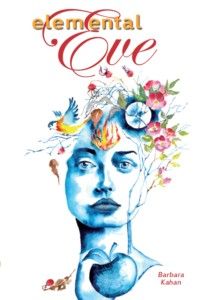Shelley A. Leedahl, Sask Books Reviews
The front and back cover images on Saskatoon writer Barbara Kahan’s complex multi-generational novel, ‘Elemental Eve’, depict two magnificent, multi-coloured watercolour paintings of women—one young, one old—set against snow-white backgrounds. Before reading even the first word, I paused to appreciate Wendy Winter’s cover illustrations: this is one of the most attractive books I’ve seen in a long time.
Metaphorically speaking, Elemental Eve is a labyrinthine river with numerous tributaries, flood plains and wetlands. The plot concerns four different “Eves”. There’s Millennium Eve, a revered artist who lives in Regina. She’s the great- grandmother of Future Eve (Evie), a young New Zealander and self-professed “wanna-be artist with no talent” who travels to Canada to speak with a third woman, Solloway, a close friend of Millennium Eve’s. Soloway grew up in Regina, worked in Toronto for many years, and retired to a cabin in northern Saskatchewan. Two other Eves—Biblical Eve (she has intellectual conversations with the Serpent) and Prime Eve (who “climbed out of the briny sea billions of years ago”)—appear less frequently in this heavily-populated novel that spans the length of history and beyond: it concludes in 2062.
Though the youngest Eve is the only character whose chapters appear in First Person, I consider Solloway the metaphorical river’s source here. Solloway—an author, professor, and daughter of parents who died in a murder-suicide—has “Indigenous heritage,” and she’s on a mission to locate Evie’s sister, who may or may not even exist, because Solloway promised Millennium Eve that she’d find the mystery girl.
Evie has never known who her father is and has “a desperate need” for more family. She leaves Kerikeri, NZ and travels to Solloway’s cabin hoping to learn more about her great grandmother, who died just before she was born “but felt like a living presence in [Evie’s] life”.
The author includes a list of the important characters, a timeline, and a map to help sort out the who, where and whens of this sprawling story in which family, belonging, the arts, and learning the answer to why we’re on this earth are explored. Even the Serpent questions its existence: “’I have a feeling I am here for a purpose that I know nothing of, and won’t know until I have fulfilled it’”.
After Millennium Eve’s husband dies, she asks herself: “Who am I?” By age sixty-eight she determines that she’s “A Jewish romantic existentialist socialist anarchist”. Evie decides that Eve is a hero, and says: “Every time I see one of her shimmering masks or luminous scenes or glowing paintings, I discover a truth about myself”.
This thought-provoking story is about women searching for their true purpose in life, about sisterhood by birth and by choice (Solloway and Eve are as close as sisters, and the latter’s first line in the book is “’Every woman needs a sister’”), and mother-daughter relationships. It’s also about sharing stories, self-doubt, and all the digressions (flood plains, wetlands) one makes on her journey toward the inevitable sea.
‘Elemental Eve’ is written by Barbara Kahan, illustrated by Wendy Winter, and published by Wild Safe Press. This book is available at your local bookstore or from www.skbooks.com.


